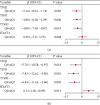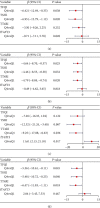Impaired Sensitivity to Thyroid Hormones Is Associated With the Change of Abdominal Fat in Euthyroid Type 2 Diabetes Patients: A Retrospective Cohort Study
- PMID: 38712310
- PMCID: PMC11073852
- DOI: 10.1155/2024/8462987
Impaired Sensitivity to Thyroid Hormones Is Associated With the Change of Abdominal Fat in Euthyroid Type 2 Diabetes Patients: A Retrospective Cohort Study
Abstract
Background and Aims: This study is aimed at investigating the potential correlation of thyroid hormone sensitivity with visceral fat area (VFA), subcutaneous fat area (SFA), and body mass index (BMI) among euthyroid type 2 diabetes mellitus (T2DM) subjects. Methods: Thyroid hormone sensitivity indices were calculated by thyroid feedback quantile-based index (TFQI), TSH index (TSHI), thyrotropin thyroxine resistance index (TT4RI), and free thyroxine (fT4)/free triiodothyronine (fT3) ratio. These indices were then categorized into quartiles for analysis. The outcomes were the change rates in VFA, SFA, and BMI among the participants. Result: The present study included 921 patients, with a median follow-up of 2.2 years. In multivariate linear regression, when compared to the first quartile, SFA demonstrated a notable decline in the fourth quartile of TFQI, TSHI, and TT4RI (β coefficient = -5.78, -7.83, and - 6.84 cm2 per year), while it significantly increased in the fourth quartile of fT4/fT3 ratio (β coefficient = 6.13 cm2 per year). Similarly, in the fourth quartile of TFQI, TSHI, and TT4RI, VFA decreased significantly, evidenced by β coefficients of -5.14, -4.80, and -4.08 cm2 per year. Yet, among the quartiles of the fT4/fT3 ratio, no discernible trend in VFA was observed. There was no significant association between indices of thyroid hormone sensitivity and change in BMI. Conclusion: Impaired central sensitivity to thyroid hormones was significantly associated with the reduction of VFA and SFA, while impaired peripheral sensitivity was associated with an increase of SFA in euthyroid individuals with T2DM.
Keywords: body mass index; diabetes; subcutaneous fat area; thyroid hormone sensitivity; visceral fat area.
Copyright © 2024 Bin Cao et al.
Conflict of interest statement
The authors declare no conflicts of interest.
Figures




References
MeSH terms
Substances
LinkOut - more resources
Full Text Sources
Medical

